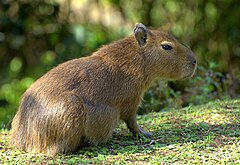Kapibary
| Hydrochoerinae | |||||
| J.E. Gray, 1825[1] | |||||
 Przedstawiciel podrodziny – kapibara wielka (Hydrochoerus hydrochaeris) | |||||
| Systematyka | |||||
| Domena | |||||
|---|---|---|---|---|---|
| Królestwo | |||||
| Typ | |||||
| Podtyp | |||||
| Nadgromada | |||||
| Gromada | |||||
| Infragromada | |||||
| Rząd | |||||
| Podrząd | |||||
| Infrarząd | |||||
| Nadrodzina | |||||
| Rodzina | |||||
| Podrodzina |
kapibary | ||||
| Typ nomenklatoryczny | |||||
|
Hydrochoerus Brisson, 1762 | |||||
| |||||
| Rodzaje | |||||
| |||||
Kapibary[12] (Hydrochoerinae) – podrodzina ssaków z rodziny kawiowatych (Caviidae).
Zasięg występowania[edytuj | edytuj kod]
Podrodzina obejmuje gatunki występujące w Ameryce Południowej[13][14][15].
Systematyka[edytuj | edytuj kod]
Do podrodziny należą dwa rodzaje żyjące współcześnie[16][13][12]:
Opisano również rodzaje wymarłe[17]:
- Cardiatherium Ameghino, 1883[18]
- Hydrochoeropsis Kraglievich, 1930[19]
- Neochoerus Hay, 1926[20]
- Phugatherium Ameghino, 1887[21]
Uwagi[edytuj | edytuj kod]
- ↑ Typ nomenklatoryczny: Hydrochaerus Erxleben, 1777 (= Hydrochoerus Brisson, 1762).
- ↑ Typ nomenklatoryczny: Kerodon F. Cuvier, 1825.
- ↑ Definiacja taksonu nie opiera się na nazwie rodzajowej.
- ↑ Typ nomenklatoryczny: †Protohydrochoerus Rovereto, 1914 (= †Phugatherium Ameghino, 1887).
- ↑ Typ nomenklatoryczny: †Cardiotherium Ameghino, 1889 (= †Cardiatherium Ameghino, 1883).
- ↑ Typ nomenklatoryczny: †Cardiatherium Ameghino, 1883.
- ↑ Typ nomenklatoryczny: †Anatochoerus Vucetich & Mones, 1991 (= †Cardiatherium Ameghino, 1883).
Przypisy[edytuj | edytuj kod]
- ↑ a b J.E. Gray. An Outline of an Attempt at the Disposition of Mammalia into Tribes and Families, with a List of the Genera apparently appertaining to each Tribe. „Annals of Philosophy”. New Series. 10, s. 341, 1825. (ang.).
- ↑ Ch.L. Bonaparte: Conspectus systematum Mastozoölogiae, Ornithologiae, Herpetologiae et Amphibiologiae, Ichthyologiae. Wyd. Editio altera reformata. Lugdini Batavorum: E. J. Brill, 1850, s. tabela. (łac.).
- ↑ a b P. Gervais: Zoologie et paléontologie françaises (animaux vertébrés): ou nouvelles recherches sur les animaux vivants et fossiles de la France. T. 1: Contenant l’énumération méthodique et descriptive des espèces ainsi que les principes de leur distribution géographique et paléontologique. Paris: Arthus Bertrand, 1848–1852, s. 18. (fr.).
- ↑ J.F. von Brandt. Beiträge zur nähern Kenntniss der Säugethiere Russland’s. 5. Abhandlung: Unlersuchungen uber die craniologischen Entwickelungsstufen und die davon herzuleiteten Yerwandtschaften und Classificationen der Nager der Jetztzeit, mit besonderer Beziehung auf die Gattung Castor. 2. Theil: Craniologische Charakteristik der einzeluen Nagergruppen. „Mémoires de l’Académie impériale des sciences de St.-Pétersbourg”. 6e série. Seconde partie. Sciences naturelles. 7 (2), s. 281, 1855. (niem.).
- ↑ T.N. Gill. Arrangement of the Families of Mammals; with Analytical Tables. „Smithsonian Miscellaneous collections”. 11, s. 22, 1874. (ang.).
- ↑ M. Weber: Die Säugetiere: Einführung in die Anatomie und Systematik der recenten und fossilen Mammalia. Jena: Gustav Fischer, 1928, s. 290. (niem.).
- ↑ Kraglievich 1930 ↓, s. 240.
- ↑ Kraglievich 1930 ↓, s. 241.
- ↑ G.G. Simpson. The principles of classification and a classification of mammals. „Bulletin of the American Museum of Natural History”. 85, s. 95, 1945. (ang.).
- ↑ Á. Cabrera. Catálogo de los mamíferos de America del Sur. „Revista del Museo Argentino de las Ciencias Naturales”. 4 (2), s. 583, 1961. (hiszp.).
- ↑ A. Mones. Monografía de la Familia Hydrochoeridae (Mammalia, Rodentia). Sistemática-Paleontología-Bibliografía. „Courier Forschungsinstitut Senckenberg”. 134, s. 32, 1991. (hiszp.).
- ↑ a b Nazwy polskie za: W. Cichocki, A. Ważna, J. Cichocki, E. Rajska-Jurgiel, A. Jasiński & W. Bogdanowicz: Polskie nazewnictwo ssaków świata. Warszawa: Muzeum i Instytut Zoologii PAN, 2015, s. 286. ISBN 978-83-88147-15-9. (pol. • ang.).
- ↑ a b C.J. Burgin, D.E. Wilson, R.A. Mittermeier, A.B. Rylands, T.E. Lacher & W. Sechrest: Illustrated Checklist of the Mammals of the World. Cz. 1: Monotremata to Rodentia. Barcelona: Lynx Edicions, 2020, s. 552–554. ISBN 978-84-16728-34-3. (ang.).
- ↑ T. Lacher, Jr: Family Caviidae (Cavies, Capybaras and Maras). W: D.E. Wilson, T.E. Lacher, Jr & R.A. Mittermeier: Handbook of the Mammals of the World. Cz. 6: Lagomorphs and Rodents I. Barcelona: Lynx Edicions, 2016, s. 406–438. ISBN 978-84-941892-3-4. (ang.).
- ↑ D.E. Wilson & D.M. Reeder (red.): Hydrochoerinae. [w:] Mammal Species of the World. A Taxonomic and Geographic Reference (Wyd. 3) [on-line]. Johns Hopkins University Press, 2005. [dostęp 2019-10-26].
- ↑ N. Upham, C. Burgin, J. Widness, M. Becker, C. Parker, S. Liphardt, I. Rochon & D. Huckaby: Treeview of Mammalian Taxonomy Hierarchy. [w:] ASM Mammal Diversity Database (Version 1.11) [on-line]. American Society of Mammalogists. [dostęp 2023-10-16]. (ang.).
- ↑ J.S. Zijlstra, Hydrochoerinae Gray, 1825, Hesperomys project (Version 23.8.1), DOI: 10.5281/zenodo.7654755 [dostęp 2023-10-16] (ang.).
- ↑ F. Ameghino. Sobre una nueva colleción de mamíferos fósiles recogidos por el profesor Scalabrini en las barrancas del Paraná. „Boletin de la Academia Nacional de Ciencias en Córdoba, República Argentina”. 5, s. 270, 1883. (hiszp.).
- ↑ L. Kraglievich. La Formación Friasiana del río Frías, río Fénix, laguna Blanca, etc., y su fauna de mamíferos. „Physis”. 10, s. 159, 1930. (hiszp.).
- ↑ A collection of Pleistocene vertebrates from southwestern Texas. „Proceedings of the United States National Museum”. 68 (2625), s. 6, 1926. (ang.).
- ↑ F. Ameghino: Apuntes preliminares sobre algunos mamíferos estinguidos del yacimiento de „Monte Hermoso” existentes en el „Museo La Plata”. Buenos Aires: El Censor, 1887, s. 6. (hiszp.).
Bibliografia[edytuj | edytuj kod]
- L.J. Kraglievich. Los más grandes carpinchos actuales y fósiles de la subfamilía Hydrochoerinae. „Anales de la Sociedad Científica Argentina”. 110 (1), s. 233–250, 1930. (hiszp.).
